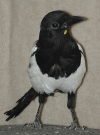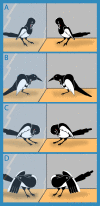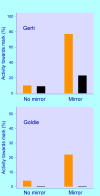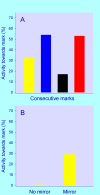Mirror-induced behavior in the magpie (Pica pica): evidence of self-recognition
- PMID: 18715117
- PMCID: PMC2517622
- DOI: 10.1371/journal.pbio.0060202
Mirror-induced behavior in the magpie (Pica pica): evidence of self-recognition
Abstract
Comparative studies suggest that at least some bird species have evolved mental skills similar to those found in humans and apes. This is indicated by feats such as tool use, episodic-like memory, and the ability to use one's own experience in predicting the behavior of conspecifics. It is, however, not yet clear whether these skills are accompanied by an understanding of the self. In apes, self-directed behavior in response to a mirror has been taken as evidence of self-recognition. We investigated mirror-induced behavior in the magpie, a songbird species from the crow family. As in apes, some individuals behaved in front of the mirror as if they were testing behavioral contingencies. When provided with a mark, magpies showed spontaneous mark-directed behavior. Our findings provide the first evidence of mirror self-recognition in a non-mammalian species. They suggest that essential components of human self-recognition have evolved independently in different vertebrate classes with a separate evolutionary history.
Conflict of interest statement
Figures




Comment in
-
The thief in the mirror.PLoS Biol. 2008 Aug 19;6(8):e201. doi: 10.1371/journal.pbio.0060201. PLoS Biol. 2008. PMID: 18715116 Free PMC article.
Similar articles
-
Mirror-mark tests performed on jackdaws reveal potential methodological problems in the use of stickers in avian mark-test studies.PLoS One. 2014 Jan 27;9(1):e86193. doi: 10.1371/journal.pone.0086193. eCollection 2014. PLoS One. 2014. PMID: 24475085 Free PMC article.
-
Crows (Corvus corone ssp.) check contingency in a mirror yet fail the mirror-mark test.J Comp Psychol. 2020 May;134(2):158-169. doi: 10.1037/com0000195. Epub 2019 Oct 7. J Comp Psychol. 2020. PMID: 31589059
-
Replication of the mirror mark test experiment in the magpie (Pica pica) does not provide evidence of self-recognition.J Comp Psychol. 2020 May 14. doi: 10.1037/com0000223. Online ahead of print. J Comp Psychol. 2020. PMID: 32406720
-
Mirror self-recognition: a review and critique of attempts to promote and engineer self-recognition in primates.Primates. 2015 Oct;56(4):317-26. doi: 10.1007/s10329-015-0488-9. Epub 2015 Sep 4. Primates. 2015. PMID: 26341947 Review.
-
The nature of visual self-recognition.Trends Cogn Sci. 2013 Mar;17(3):121-7. doi: 10.1016/j.tics.2013.01.004. Epub 2013 Feb 12. Trends Cogn Sci. 2013. PMID: 23410584 Review.
Cited by
-
Cleaner fish with mirror self-recognition capacity precisely realize their body size based on their mental image.Sci Rep. 2024 Sep 11;14(1):20202. doi: 10.1038/s41598-024-70138-7. Sci Rep. 2024. PMID: 39261520 Free PMC article.
-
Human brain organoid code of conduct.Front Mol Med. 2023 Mar 23;3:1143298. doi: 10.3389/fmmed.2023.1143298. eCollection 2023. Front Mol Med. 2023. PMID: 39086687 Free PMC article.
-
Domestic chickens solving mirror-mediated spatial location tasks uncovering their cognitive abilities.Sci Rep. 2024 Jun 19;14(1):14164. doi: 10.1038/s41598-024-64743-9. Sci Rep. 2024. PMID: 38898056 Free PMC article.
-
Entopallium Lost GFAP Immunoreactivity during Avian Evolution: Is GFAP a "Condition Sine Qua Non"?Brain Behav Evol. 2023;98(6):302-313. doi: 10.1159/000535281. Epub 2023 Dec 9. Brain Behav Evol. 2023. PMID: 38071961 Free PMC article.
-
Roosters do not warn the bird in the mirror: The cognitive ecology of mirror self-recognition.PLoS One. 2023 Oct 25;18(10):e0291416. doi: 10.1371/journal.pone.0291416. eCollection 2023. PLoS One. 2023. PMID: 37878556 Free PMC article.
References
-
- Gallup GG., Jr Chimpanzees: self-recognition. Science. 1970;167:86–87. - PubMed
-
- Lethmate J, Dücker G. Untersuchungen zum Selbsterkennen im Spiegel bei Orang-Utans und einigen anderen Affenarten. Z Tierpsychol. 1973;33:248–269. - PubMed
-
- Walraven V, van Elsacker L, Verheyen R. Reactions of a group of pygmy chimpanzees (Pan paniscus) to their mirror images: evidence of self-recognition. Primates. 1995;36:145–150.
-
- Ledbetter DH, Basen JA. Failure to demonstrate self-recognition in gorillas. Am J Primatol. 1982;2:307–310. - PubMed
-
- Hyatt CW. Responses of gibbons (Hylobates lar) to their mirror images. Am J Primatol. 1998;45:307–311. - PubMed
Publication types
MeSH terms
LinkOut - more resources
Full Text Sources
Other Literature Sources
Research Materials


